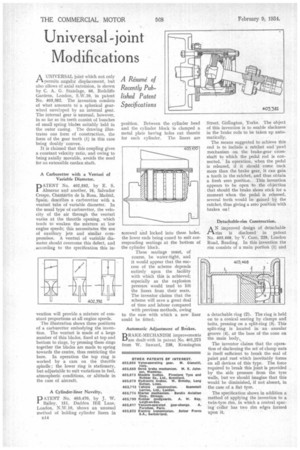Universal -joint Modifications
Page 128

If you've noticed an error in this article please click here to report it so we can fix it.
A'UNIVERSAL joint which not only permits angular displacement, but also allows of axial extension, is shown by C. A. G. Standage, 66, Redcliffe Gardens, London, SAVA°. in patent No. 403,382. The invention consists of what amounts to a spherical gearwheel enveloped by an internal gear. The internal gear is unusual, however, in so far as its teeth consist of bunches of small spring blades suitably held in the outer casing. The drawing illustrates one form of construction, the form of the gear teeth (1) in this case being doubly convex.
It is claimed that this coupling gives a constant velotity ratio, and owing to being axially movable, avoids the need for an extensible cardan shaft.
A Carburetter with a Venturi of Variable Diameter.
DATENT No. 402,592, by E. S.
Almaraz and another, 16, Salvador Crespo, ChaMartin de la Rosa, Madrid, Spain, describes a carburetter with a venturi tube of variable diameter. In the usual type of carburetter, the velocity of the air through the venturi varies at the throttle opening, which tends to weaken the mixture at low engine speeds; this necessitates the use of auxiliary jets and similar compromises. A venturi of variable diameter should overcome this defect, and ,according to the specification this in
vention will provide a mixture of Constant proportions at all engine speeds.
The illustration shows three positions of a carburetter embodying the invention. The venturi is made of a large number of thin blades, fixed at top and bottom to rings, by pressing these rings together the blades are made to spring towards the centre, thus restricting the bore, In operation the top ring is worked by a cam on the throttle spindle ; the lower ring is stationary, but adjustable to suit variations in fuel, atmospheric conditions, or altitude in the case of aircraft.
A Cylinder-liner Novelty.
pATENT No. 403,479, by J. W. Bailey, 151, Ducklen Hill Lane, London, N.W.10, shows an unusual method of holding cylinder liners in
D14
position. Between the cylinder head and the cylinder block is clamped a metal plate having holes cut therein for each cylinder. The liners are screwed and locked into these holes, the lower ends being coned to suit corresponding seatings at the bottom of the cylinder block.
These seatings must, of course, be water-tight, and it would appear that the success of the scheme depends entirely upon the .facility with which this is achieved; especially as the explosion pressure would tend to lift the liners from their seats. The inventor claims that the scheme will save a great deal of time and labour compared with previous methods, owing to the ease with which a new liner could be fitted.
Automatic Adjustment of Brakes.
BRAKE-MECHANISM improvements are dealt with in patent No. 401,273 from W. Saward, 238, Kensington
Street, Girrington, Yorks. The object of this invention is to enable slackness in the brake rods to be taken up automatically.
The means suggested to achieve this end is to include a ratchet and pawl mechanism on the brake-gear crossshaft to which the pedal rod is connected. In operation, when the pedal is released, if it should come back more than the brake gear, it can gain a tooth in the ratchet, and thus obtain a fresh hero position. This invention appears to be open to the objection . that should the brake shoes stick for a moment when the pedal is released, several teeth would be gained by the ratchet, thus giving a zeto position With brakes on!
Detachable-rim Construction.
AN improved design of detachable rim is disclosed in patent No. 403,468, by V. Caro, 229, London Road, Reading. In this invention the Tim consists of a main portion (1) and a detachable ring (2). The ring is held on to a conical seating by clamps and bolts, pressing on a split-ring (3). This split-ring is located in an annular groove (4). at the base of the cone On the main body,
The inventor claims that the operation of slackening the set of clamp nuts is itself sufficient to break the seal of paint and rust which inevitably forms on all devices of this type. The force required to break this joint is provided by the side pressure from the tyre walls, but we should imagine that this would be diminished, if not absent, in the case of a flat tyre.
The specification shows in addition a method of applying the invention to a twin-tyre rim, in which a central spacing collar has two rim edges formed upon it.




































































































































































